Mobile Core i7 920XM, Clarksfield: Nehalem on-the-go
by Jarred Walton on September 23, 2009 10:00 AM EST- Posted in
- Laptops
Gaming Performance
For this initial look, we've trimmed our usual battery of game tests down to eight titles. We still have one "simulation" (GRID), four first-person shooters, two role-playing games, and one strategy game. All of these gaming tests were run at 1920x1080 using High/Very High detail settings. For the Clarksfield system, this required the use of an external LCD since otherwise we would be limited to 1600x900.
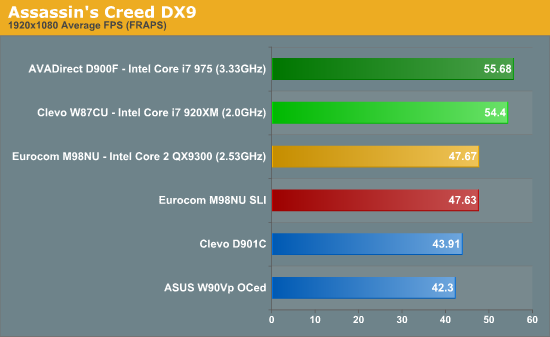
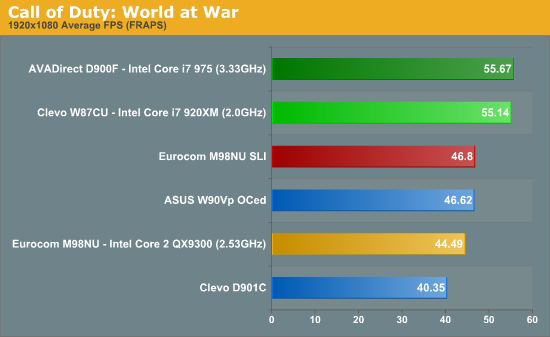
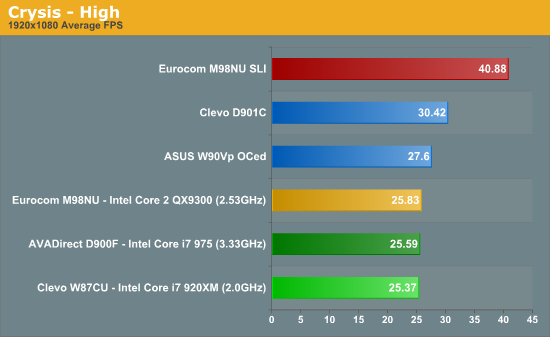


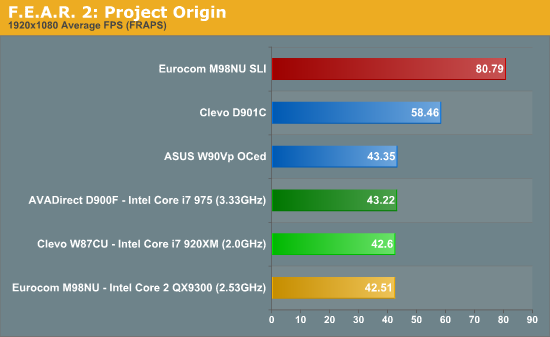
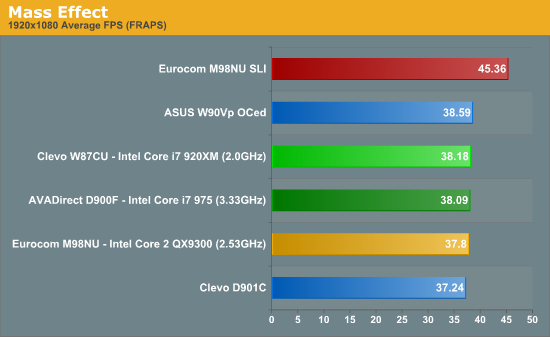
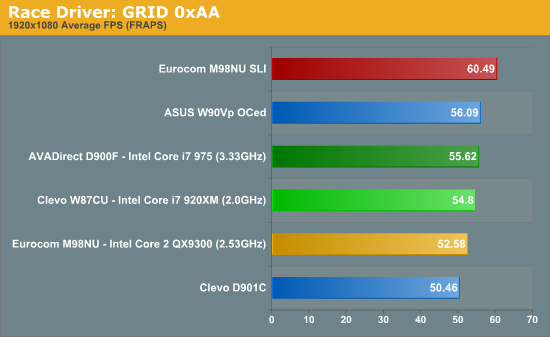
It's clear that we are GPU limited at these settings in some of the titles, but a few games are also clearly CPU limited. Falling into the CPU limited category, Assassin's Creed and Call of Duty: World at War both show similar performance with the i7 systems and show little if any benefit to SLI. The QX9300 in the Eurocom is 15~25% slower than the i7-920XM in these two titles.
Most of the games show a clear benefit for SLI, however, and likewise they show that the GTX 280M is a bottleneck for gaming performance. SLI improved performance by 15% in GRID, 20% in Mass Effect, and almost 30% in Far Cry 2. The big winners for SLI are Crysis (~60% boost from SLI), F.E.A.R 2 (90% boost), and Empire: Total War (99% faster with SLI).
If you're after optimal gaming performance, obviously just getting the fastest CPU or the fastest GPU alone won't cut it in every situation. You need a balanced platform with a CPU and GPU matched to offer the best performance in a large variety of situations. QX9300 with GTX 280M SLI often tips the scales too far towards the GPU side of the equation, while i7-975 is complete overkill for a single GTX 280M (about the level of a desktop 9800 GTX+/GTS 250).
We are definitely interested in seeing what the i7-920XM - as well as the i7-820QM and i7-720QM - can do with SLI graphics in the future. We're also looking forward to the day when we see mobile versions of stuff like the HD 5870, preferably with power gate transistors.










63 Comments
View All Comments
strikeback03 - Wednesday, September 23, 2009 - link
So when are we going to see Arrandale? At these prices not so interested in Clarksfield.strikeback03 - Wednesday, September 23, 2009 - link
Also, probably Dragon error:If you're after optimal gaming performance, obviously just kidding, the fastest CPU or the fastest GPU alone won't cut it in every situation.
bottom of page 7.
JarredWalton - Wednesday, September 23, 2009 - link
I have no idea what I was even trying to say on that one. Hmmm.... Dragon at 8AM after working for 20 hours straight is NOT my friend! :-) Oh, wait: "just getting" without the comma should work.As for Arrandale, it's due out in Q1 2010, so not too far off. 32nm and dual-core + Hyper-Threading should be very compelling I think.
strikeback03 - Thursday, September 24, 2009 - link
yeah, just getting is what I assumed it was.So no Arrandale before Christmas? That's too bad.
TA152H - Wednesday, September 23, 2009 - link
Finally a review conclusion I can agree with.Dual core with hyperthreading should be better. I also don't think laptops will replace desktops for gaming. Is Intel crazy? That's just such a strange prediction, I don't know why they would think it's even remotely possible.
I think they should have waited for 32nm before releasing a Nehalem for mobile. Really, they have no competition from AMD worth speaking about, and 32nm could have been done right - with an integrated IGP if desired, and low enough power use that it's not one hour and out.
A micro-ATX setup with a handle, a Bloomfield and a real video card would probably be better for the vast majority of gamers than this one. You don't get true portability, but with only one hour of life, you don't really get it with this either.
The gloom and doom for desktops is always overstated. For one, laptops are really only comfortable for women and weak, pencil-necked men. If you have any size, the keyboard is a nightmare, and none come with the natural keyboard which men's shoulder width really begs for.
On top of this, mouse movement is a pain in the neck with that replacement. A mouse is just more comfortable. Then you have to worry about power, which kind of ruins a lot of the fun with computers - just kind of doing what you feel like and relaxing. Who wants to worry about power? Then, you're limited by screens. Of course, you can dock these things, and use them as desktops, in which case they only have disadvantages (although not as many) in this role, and no advantages.
So, I think desktops will always be around, and always be the preferred tool even if you have both.
I think one reason laptops sell pretty well is, ironically, because they are unreliable, and need replacement much more often. They are also more difficult to upgrade, also necessitating replacement rather than upgrade. So, the reasons aren't all good.
Penti - Saturday, September 26, 2009 - link
To be fair it's a desktop replacement cpu, like their many released before. Yes it will replace desktops for gaming but only for some. DTR cpus are also used for high-end mobile workstations. It's not for everybody get your grip together. They don't do everything because competition from AMD.goinginstyle - Wednesday, September 23, 2009 - link
The cut and paste king is at it again."A micro-ATX setup with a handle, a Bloomfield and a real video card would probably be better for the vast majority of gamers than this one. "
You have to be kidding, Lynnfield offers far superior power management and consumption plus better overall performance than Bloomfield. Something you would actually want in a micro-ATX setup, instead of a heat generator like Bloomfield. Even the Phenom/Athlon II would make for a better micro-ATX gaming platform than the energy sucking Bloomfield.
Before you get on your high horse about Bloomfield and overclocking, it's not going to make any difference in a micro-ATX system compared to Lynnfield, except to make the temperatures unbearable.
How is that next cut and paste article coming along for Toms? Are you going to do the history of lawnmowers on this one?
TA152H - Wednesday, September 23, 2009 - link
Dude, are you gay or something? What is your obsession with me?Wouldn't your current boyfriend be upset if he saw your obsession.
Micro-Atx would, naturally, be plugged in. What kind of an idiot are you? Battery life wouldn't matter in this context. The micro-ATX would be for easy movement from one place to another. Some of them are really small, light (so even you could move it), and easily transported. I wasn't implying you'd want to use it from a battery.
Didn't you understand that within the context? Clearly, you're a moron. And a gay, obsessive one. Get a life. You need attention, clearly, but not from me. Find someone else.
goinginstyle - Wednesday, September 23, 2009 - link
What is your obsession with posting negative comments to every article at AT? They have proven you wrong every step of the way. Why they even wasted their time is beyond me but I have to hand it to them for even paying attention to you.You obviously do not make these sames posts at Toms? I just read through the comments on the last six or seven articles. Especially the cpu related ones and you did not make a single comment even though their conclusion, test methods, and information is nearly the same at ATs when comparing Lynnfield vs Bloomfield. Why is that?
You brought up the Bloomfield micro-ATX setup and I was just replying to one not so bright idea of yours about Bloomfield once again being superior. The last thing you want in a micro-ATX system you will be lugging around to LAN parties is a Bloomfield cpu and X58 chipset. Heat is thy enemy and this platform has ridiculous power consumption compared to Lynnfield or Phenom II. Considering the alternatives available I would say Bloomfield should be one of the last ones to suggest.
TA152H - Wednesday, September 23, 2009 - link
You're really not that stupid, are you?My post wasn't negative. I agreed with the author. I don't agree with Intel, and neither did he. What is your problem, besides liking me?
They didn't prove anything, at all. You're just too stupid to see through the weird benchmarking. Maybe I stopped reading before they posted their 'proof'. But, really, Anand's apple to apple benches proved my point. In their first article, they were saying they were the same or better. Then, all of the sudden, the Bloomfield is 3.5% faster, normalized! Sometimes almost 10%, on real world benchmarks. Fancy that! Although, this time they screwed up by making the Bloomfield uncore faster, so it's not 100% accurate.
Tom's also showed a lot of advantages of the Bloomfield. This site just rubbed me the wrong way because they were doing whatever they could to make the Lynnfield look better than it really is. Is 3% a big deal? Who knows? Maybe it is, maybe it isn't. That's a matter of perspective. But, when I see 0%, or -1%, and I know it's just not so, that's where someone has to say something. If they were arguing 3% isn't so important, then, so be it. But, show the 3%, instead of hiding it behind bogus setups that hide it.
You wouldn't understand because you're simple. But, life isn't simple. Very few things are good or bad, completely.
By the way, why would power matter more for micro-ATX than for anything else? The Bloomfield is king of the hill. I'm not crazy about the power use, really, I'm not, but, for a gaming platform, I'd want the best. I'd put up with the additional power use.
For a computer I'd put in the kitchen and would only surf on, I'd probably be much more inclined to look at power. Of course, even then I wouldn't consider the Lynnfield. I'd get a Core 2 or Pentium, a G45, and get all the performance I needed.
Also, you probably didn't notice, because Gary hid it, that the voltage needed to overclock the Lynnfield was considerably higher than the Bloomfield. That makes me a little nervous. But, still, I agree completely the x58 needs to go on a diet. I wish Intel would move it down to 45nm. It's a high end platform, it deserves it.
So, it's not the size, it's the application. Hmmmm, that could have a different context, but, remember we're talking about computers here.